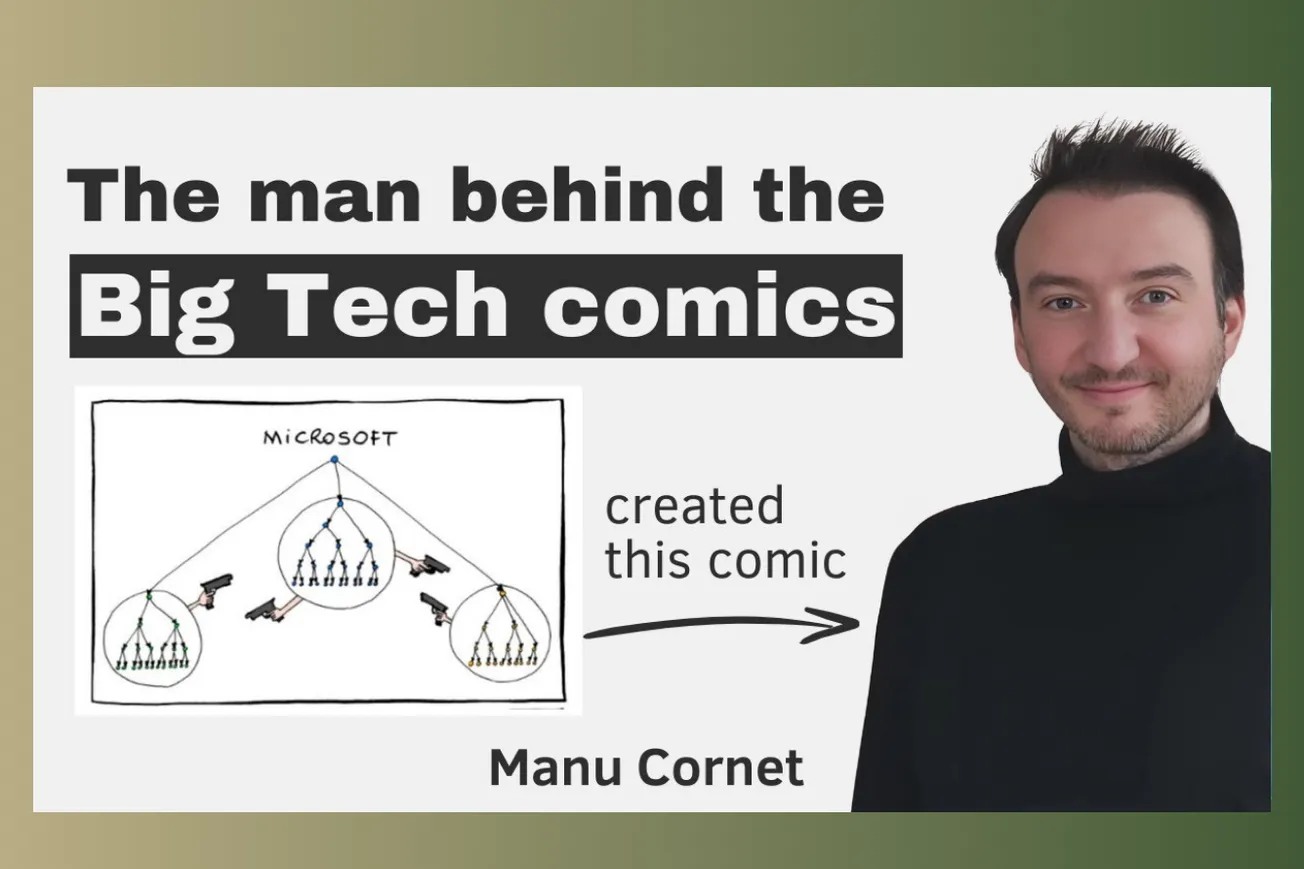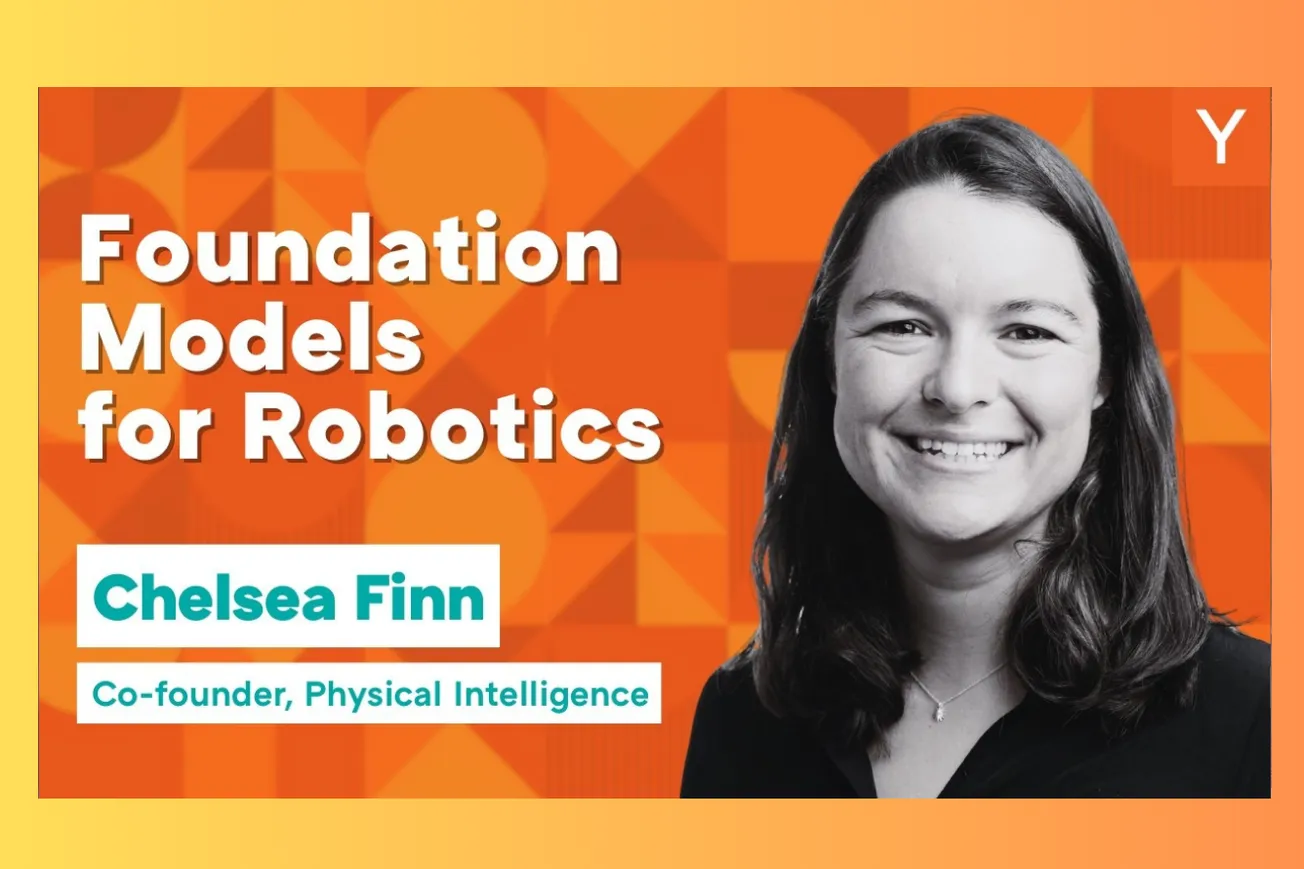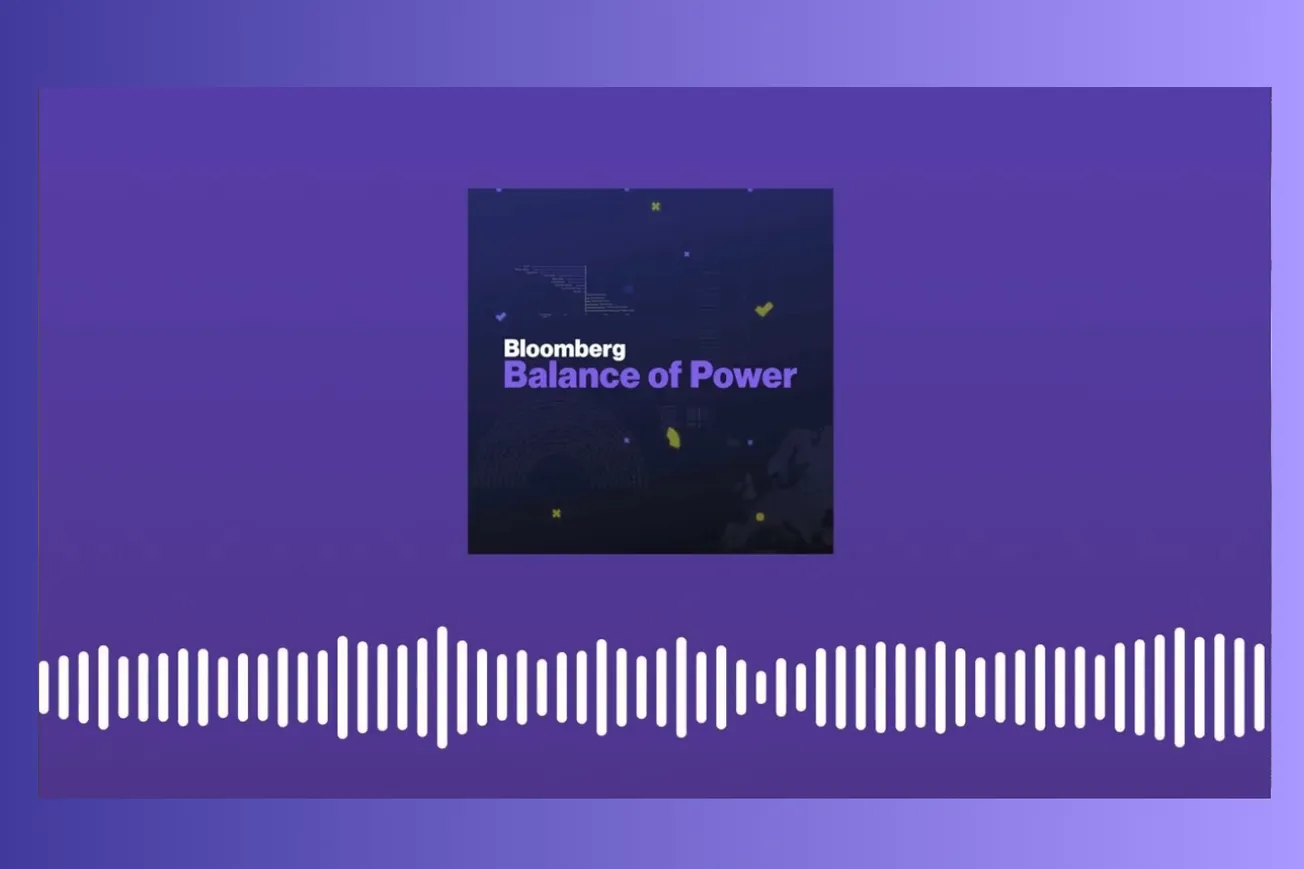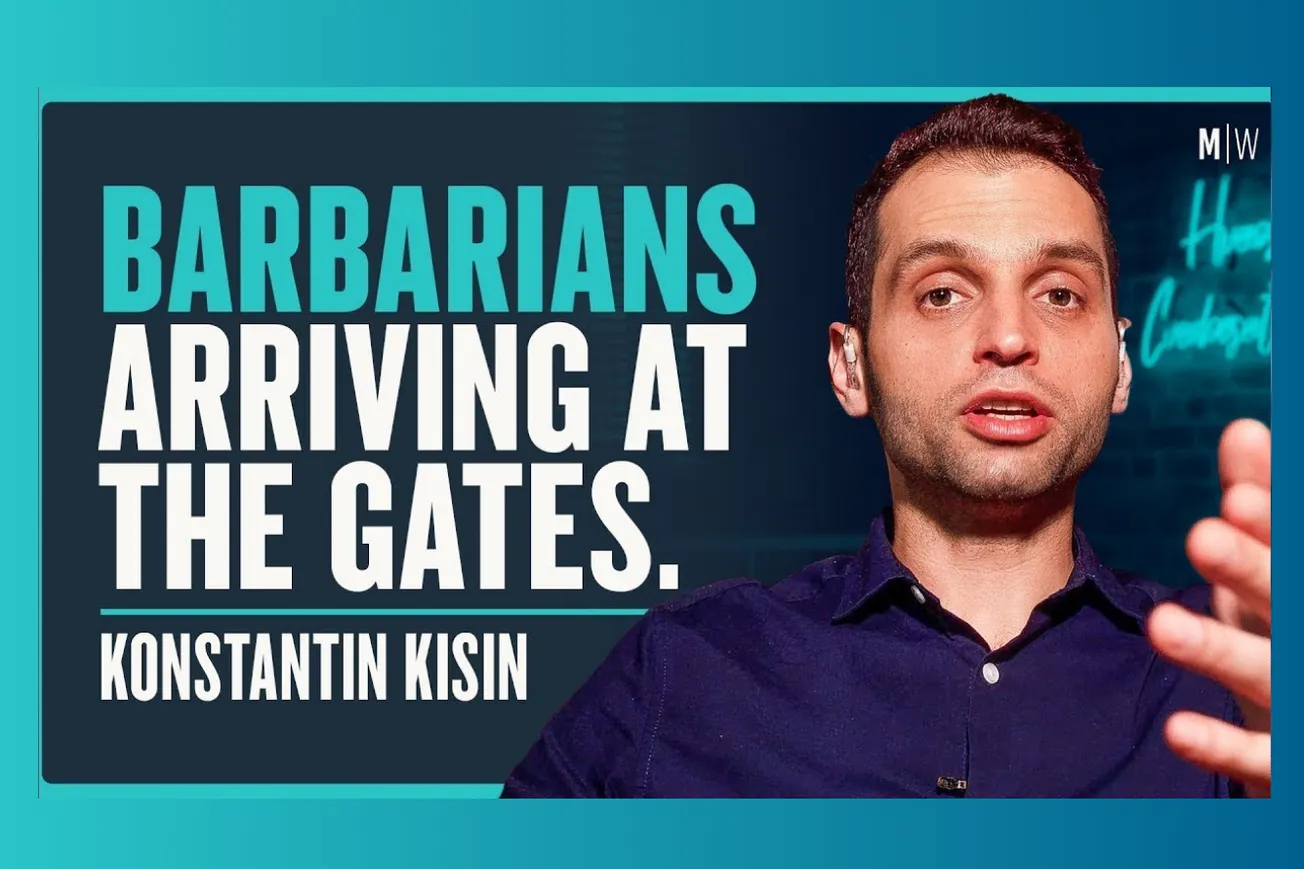Table of Contents
Manu Cornet reveals the stories behind his viral tech comics, from the org chart that perfectly captured company cultures to predicting Google Stadia's failure on launch day.
A Google engineer's 2011 org chart comic remains remarkably accurate today, capturing the fundamental cultural differences between Amazon's hierarchy, Apple's centralization, and Google's bottom-up chaos.
Key Takeaways
- The famous 2011 org chart comic almost wasn't published because Manu didn't find it funny after spending time drawing it—yet it became his most referenced work
- Google's naming confusion stems from its bottom-up culture where employees start competing projects without top-down coordination, creating product duplication
- Manu's tailgating security comic was printed on every Google office door worldwide, demonstrating how humor can effectively communicate serious security messages
- Google's 20% time genuinely fostered innovation (Gmail, Google News) but was gradually discouraged as the company became more traditional and siloed
- Manu correctly predicted Google Stadia's failure on launch day through a comic showing developers ignoring the "Google graveyard" of discontinued products
- Twitter's culture initially felt like "young Google" with less bureaucracy, but the Elon Musk acquisition brought rapid cultural destruction within months
- Direct user feedback loops are rare in big tech companies, making engineers feel disconnected from the people using their products
- Tech companies face fundamental trade-offs between employee freedom (Google's approach) and customer focus (Amazon's approach)
Timeline Overview
- 00:00–02:01 — Intro: Introduction to Manu Cornet, Google engineer and creator of viral tech comics
- 02:01–07:10 — Manu's org structure comic: The creation and near non-publication of the famous 2011 org chart comic
- 07:10–09:15 — Manu's "Who Sues Who" comic: Patent litigation mess in tech with Nokia burning alone in the corner
- 09:15–14:10 — Google vs. Amazon comic: Guns and roses metaphor showing different approaches to employees vs customers
- 14:10–20:00 — Confusing names at Google: Why Google constantly renames products and the cultural roots of this problem
- 20:00–22:20 — Different approaches to sharing information within companies: Trade-offs between Apple's secrecy and Google's openness
- 22:20–25:15 — The two ways of doing things at Google: Deprecated way vs the way that doesn't work yet
- 25:15–27:45 — Manu's code reviews comic: How many people it takes to screw in a lightbulb in tech companies
- 27:45–30:55 — The comic that was printed on every single door of Google: Tailgating security awareness through the "tail-gator" pun
- 30:55–36:00 — An explanation of 20% at Google: How the innovation program worked and why it was gradually discouraged
- 36:00–41:36 — Gmail Labs and Google Stadia: Better ways to launch experimental features and predicting product failures
- 41:36–47:07 — Manu's time at Twitter and the threat of Elon Musk buying: Initial culture similarity to early Google and acquisition uncertainty
- 47:07–49:05 — How Manu helped Gergely with a bug on Twitter: The importance of direct user feedback and engineer-user connections
- 49:05–59:00 — Musk's acquirement of Twitter and the resulting layoffs: 80% workforce reduction and random firing patterns
- 59:00–1:02:37 — Manu's comic about his disillusionment with Twitter and Google: Capitalism killing ideals in 10 years vs 3 months
- 1:02:37–END — Rapid fire round: Programming language preferences and book recommendations
The Org Chart Comic That Defined Tech Culture
Manu's 2011 org chart comic capturing Amazon, Google, Facebook, Apple, Oracle, and Microsoft has remained remarkably prescient, reflecting fundamental cultural DNA that persists across these companies.
- The comic almost wasn't published because Manu had lost perspective after spending time drawing it, highlighting how creators can lose objectivity about their work
- Amazon was depicted as the "base case" with a standard hierarchical tree structure, representing traditional corporate organization
- Apple's centralized structure with everything flowing through one person perfectly captured Steve Jobs' control and the company's continued top-down approach
- Google's chaotic, interconnected mess reflected its bottom-up culture where engineers have significant autonomy to start projects
- Microsoft showed departments in conflict with each other, representing the internal competition that characterized old Microsoft culture
- Oracle's structure emphasized a large legal department with tiny engineering, reflecting their litigation-heavy business model during the Java lawsuits
The enduring accuracy of these characterizations demonstrates how organizational structure reflects and reinforces company culture in ways that persist across leadership changes and market evolution.
Google's Naming Problem: The Dark Side of Bottom-Up Culture
Google's notorious product naming confusion stems from cultural strengths that create unintended consequences when scaled across a large organization.
- Bottom-up culture encourages employees to start projects freely, leading to multiple teams working on similar or competing efforts
- The naming chaos reflects deeper organizational challenges where lack of top-down coordination creates product duplication
- Even in 2007, during Manu's interviews, Google engineers identified duplication and competing efforts as major cultural drawbacks
- Payment products exemplify the problem—Google Wallet became Android Pay, then Google Pay, with multiple apps existing simultaneously
- The company prioritizes being "nice to employees" over customer clarity, leading to shipping the org chart confusion to users
- Current leadership approaches problems through appeasement rather than consolidation, avoiding the tough decisions needed for product clarity
This pattern reveals how cultural values can create systematic problems that become harder to solve as organizations grow and entrench existing approaches.
Security Through Humor: The Tailgating Comic Success
Manu's security awareness comic demonstrates how humor can effectively communicate serious corporate policies while maintaining employee engagement.
- The "tail-gator" pun comic was printed on every Google office door worldwide, showing the global reach of effective internal communications
- Google faced real security issues with employees letting unauthorized people into offices due to the company's friendly, open culture
- The comic succeeded because it made a serious security message memorable and approachable rather than preachy or threatening
- Annual refreshes kept the message fresh and maintained employee attention to an ongoing security concern
- The global deployment showed how good internal content can scale across diverse office cultures and languages
- Visual metaphors proved more effective than traditional security training or policy documents for behavior change
This example illustrates how creative communication approaches can solve real business problems while reinforcing positive company culture.
The Rise and Fall of 20% Time
Google's famous 20% time policy exemplifies how innovative practices can be gradually undermined as companies become more traditional and risk-averse.
- The policy allowed employees to dedicate one day per week to projects of their choosing, fostering genuine innovation
- Major Google products including Gmail and Google News originated as 20% projects, demonstrating the program's real value
- Gmail Labs provided a model for experimental feature launches with clear user expectations about stability and support
- The program was gradually discouraged rather than officially eliminated, allowing Google to avoid admitting it was becoming conventional
- Pressure toward traditional management approaches conflicted with the experimental mindset required for 20% projects to succeed
- The decline reflected broader cultural changes as Google prioritized efficiency and predictability over innovation and employee freedom
The evolution of 20% time illustrates how cultural practices require ongoing institutional support to survive organizational growth and market pressures.
Predicting Product Failures Through Pattern Recognition
Manu's comics about Google's product discontinuations demonstrate how cultural patterns can predict individual product outcomes with remarkable accuracy.
- The Google Stadia comic created on launch day showed developers ignoring the "Google graveyard" of discontinued products
- The prediction proved accurate as Stadia was eventually discontinued, with Google providing full refunds to users
- Network effects create fundamental barriers for Google products outside their core advertising business
- Previous failures like Google Wave, Google+, and Allo demonstrated the challenge of building social platforms without existing user bases
- Steam's established gaming ecosystem made Stadia's success nearly impossible regardless of technical quality
- The pattern suggests Google's cultural approach to product development works well for some categories but fails consistently in others
This predictive accuracy comes from understanding how company culture and market dynamics interact to determine product success or failure.
Twitter's Cultural Journey: From Young Google to Chaos
Manu's experience at Twitter illustrates how company culture can change rapidly under new ownership, especially when financial pressures mount.
- Twitter initially felt like "young Google" with similar friendly culture, less bureaucracy, and focus on employee satisfaction
- The company lacked Google's advertising cash cow, making it vulnerable to financial pressures and external threats
- Elon Musk's acquisition created months of uncertainty that made normal work planning nearly impossible
- Mass layoffs affected approximately 80% of the workforce, including highly productive engineers who were later rehired
- The firing process appeared random rather than performance-based, destroying trust and institutional knowledge
- Cultural change happened dramatically faster at Twitter (3 months) compared to Google's gradual shift over years
This rapid transformation demonstrates how external ownership changes can destroy carefully built company cultures almost overnight.
The Value of Direct User Feedback
Manu's practice of directly engaging with users on social media highlights how rare and valuable these connections are in large tech companies.
- Big tech companies typically isolate engineers from users through layers of product management and user research
- Direct feedback loops allow engineers to understand real user problems rather than relying on filtered insights
- Manu actively monitored Twitter for user complaints and personally fixed reported bugs, creating immediate value
- This approach contrasts with Google's structure where customer service is nearly non-existent for free products
- User forums at companies like Google are typically avoided by engineers unless mandated by corporate programs
- Personal initiative to connect with users requires going against normal company processes and cultural expectations
These direct connections improve both product quality and engineer motivation by closing feedback loops that traditional corporate structures often break.
Common Questions
Q: Why has the 2011 org chart comic remained so accurate over time?
A: Organizational structure reflects deep cultural DNA that persists across leadership changes—Amazon's hierarchy, Apple's centralization, and Google's chaos represent fundamental approaches to decision-making and employee empowerment.
Q: What causes Google's notorious product naming problems?
A: Google's bottom-up culture encourages employees to start competing projects without top-down coordination, leading to product duplication and naming confusion that gets shipped to users.
Q: How did 20% time actually work at Google?
A: Employees could dedicate one day per week to self-chosen projects that produced major innovations like Gmail and Google News, but the program was gradually discouraged as Google became more traditional.
Q: Why do Manu's comics successfully predict product failures?
A: Understanding company culture and market dynamics allows pattern recognition—Google consistently fails at social products due to network effects, regardless of technical quality.
Q: How did Twitter's culture change under Elon Musk?
A: The company went from feeling like "young Google" with friendly culture to 80% workforce reduction and random firing patterns that destroyed institutional knowledge and trust.
Conclusion
Manu Cornet's comics provide a unique window into big tech culture that combines insider knowledge with artistic perspective. His work demonstrates how humor can reveal deeper truths about organizational behavior, cultural trade-offs, and the human cost of corporate decisions.
The enduring relevance of his 2011 org chart comic shows how fundamental organizational approaches persist across leadership changes and market evolution. These cultural patterns shape everything from product naming to employee treatment to customer focus in predictable ways.
Most importantly, Manu's work highlights the human element in technology companies—the engineers who build products, the cultural values that guide decisions, and the real impact of corporate policies on both employees and users. His comics serve as both entertainment and anthropological documentation of an industry in constant flux.
Practical Implications
- Recognize that organizational structure reflects and reinforces company culture in lasting ways that persist across leadership changes
- Understand that bottom-up cultures create innovation opportunities but also coordination challenges that scale poorly
- Use humor and creative communication to make serious messages more memorable and engaging than traditional corporate communications
- Maintain direct connections with users when possible, as corporate structures often break valuable feedback loops
- Expect cultural values to create predictable patterns in product development, marketing approaches, and employee treatment
- Prepare for rapid cultural change during ownership transitions, especially when new leadership has different values and priorities
- Balance employee freedom with customer focus, recognizing that optimizing for one often comes at the expense of the other
- Document and preserve institutional knowledge during periods of rapid change or workforce reduction
- Consider how company culture affects product success, particularly for categories requiring network effects or customer trust
- Value engineers and other employees who proactively connect with users and solve problems beyond their formal responsibilities





